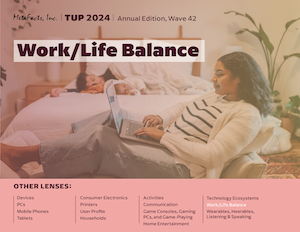
Well before COVID, digital nomads pioneered working remotely. Now many technology users are finding ways to balance getting work done with their personal lives.
Events starting in the year 2020 have made more clear what has been happening for more than a decade – the digital transformation of work. An ever-widening range of occupations have grown to support remote working. The early adopters of remote work have included two contrasting ends of a continuum – employer-lead innovations and employee-enabled adoption. Employers and employees alike have increasingly intermixed their work and personal activities, and enacted ways to use their connected devices for work and play.
Consumers and employees have choices, and are increasingly juggling multiple devices. While some market segments use their various devices for a broad and rich combination of activities, others prefer to do certain activities only one one type of device. Furthermore, many connected adults use personal devices for work-related activities and vice-versa.
Summary of subjects covered in the Work/Life Balance lens tables
| Subjects | Examples of TUP Questions Answered |
|---|---|
| Respondent Demographics | Gender, Age, Educational attainment, Employment status |
| Household Demographics | Household size, Household income, Presence of children |
| Work from Home | Working from home only – before or after February 2020 |
| Social Networks | Which social networks were visited in the prior 30 days |
| Activities | Activities regularly used on connected devices, including social networking, shopping, communication, entertainment, imaging, information/search, cloud storage/sharing, productivity/personal |
| Device Activities | The activities across all devices as well as by each device number |
Links to Work/Life Balance lens tables
This content is for subscribers only. For more information about TUP and its research results for insights professionals with technology companies, please visit MetaFacts or contact us.
Recent findings from the TUP Work/Life Balance lens
- Skype call forwarding its active base
- Aging ASUS work computers due for a refresh
- Lenovo work computer users-a stable if unexcited group
- Apple work computer users at a crossroads
- Dell’s moribund home computer base
- iPhone user base – broader and still somehow different
- Lenovo’s leading edge – in home computing
- Inertia and tradition defend Epson home printer installed base
- Windows 10 PC users up for grabs
- Home mobile computing in the balance, as users choose
- Gen Z gets the used/refurbished work PCs
- Employees expect remote work arrangements to endure
- The technology remote workers want
- The aging home computer installed base as most generations delay refreshing
- Home printer market growth quadrants & long-term trends
- The connection between AI-assisted activities and home printing
- American employees and AI-assisted use cases – an emerging yet complicated work relationship
- Younger workers extend remote working trend
- Remote workers continue paying own phone bills
- Remote work continues to pay off for American employees
For more information about TUP, MetaFacts deliverables
This content is for subscribers only. For more information about TUP and its research results for insights professionals with technology companies, please visit MetaFacts or contact us.

